The second Nagorno-Karabakh War, which occurred in 2020, resulted in substantial alterations in the Caucasus area. These changes extended beyond the region’s map. Azerbaijan liberated most of its occupied territories during the 1990s war and has gained increasing military and diplomatic power in the region. As of 2020, peace discussions are ongoing, but no resolution has emerged as of yet. Since January 2023, the Lachin Corridor, an area of geopolitical significance, has become increasingly tense. This article will discuss the normalisation process between Azerbaijan and Armenia, Turkey’s involvement as a neighbouring country, the causes of tension in the Lachin Corridor, and the current situation.
Azerbaijan lost control of many regions to Armenia during the conflicts between 1988-1994. This conflict, resulting from policies implemented in the latter years of the Soviet Union, persisted following the dissolution of the USSR. Over a million Azerbaijanis were forced to vacate their homes. Furthermore, it is acknowledged that Azerbaijani communities residing in and around Nagorno-Karabakh fled to evade persecution and hostility from Armenia. From 1991 onwards, Armenian assaults have occupied a range of territories, including Khankendi, Lachin, Kalbajar, and Aghdam. In addition, the Khojaly Massacre occurred during the war and resulted in the deaths of hundreds of Azerbaijani civilians, including women and children. The Bishkek Protocol in 1994 called for a ceasefire and the withdrawal of forces from occupied territories, as well as the eventual signing of a peace agreement. Nevertheless, low-level conflict persisted until 2020 without a final peace agreement in place. It should be noted that a fifth of Azerbaijan’s territory is currently occupied.
During the war between the two former Soviet countries, Russia was expected to take the lead in persuading the parties to end the conflict. However, Russia remained passive, particularly while Azerbaijan’s lands were being occupied and its people were being forced to migrate. Unfortunately, other regional and international organizations, including the OSCE, also failed to play an active role in resolving the tensions in the area. In 1992, the OSCE Minsk Group co-chaired by the US, France, and Russia aimed to resolve the Karabakh conflict through multiple meetings, albeit unsuccessfully. This outcome indicates the insufficient capacity of OSCE. It is seen that the co-chairs cannot play an effective role in solving the problem. In the 2020 war, Armenia anticipated direct support from Russia, but since the 1990s, Russia abstained from intervening in the conflict directly. This policy has enabled Russia to more easily exert control over both warring countries. Despite the Kremlin’s leading role in the normalization process between Azerbaijan and Armenia, which began in 2020, its policy of not forcing these countries to reach a peace agreement contributes to maintaining their dominance over the region. Hence, it can be contended that Russia’s approach to resolving the conflict has remained unaltered for a significant duration.
…




